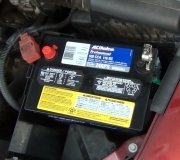There are two problems with your test method. The first is, while the test light did indeed show there is a draw, it takes a good quarter amp to make the filament glow enough to see. Unless specified differently by the manufacturer, the maximum allowable drain is 35 milliamps, (.035 amps). At that rate, a good, fully-charged battery will still crank an engine fast enough to start after sitting for three weeks. You could have a tenth of an amp draw, which is three times what is allowable, and never see it with a test light. You need to use a digital volt/ohm/amp meter on the amps ranges to accurately check for a draw.
The second problem is by the mid 1990's, a lot of cars had engine computers or body computers that needed up to twenty minutes to go to "sleep" mode. Until they did that, they could draw up to three amps. More importantly, doing anything to break the circuit, even for an instant, wakes those computers up again, and you have to wait for up to another twenty minutes.
Most digital meters have a two-amp internal fuse for the volts, resistance, and most of the amps ranges. A computer drawing three amps will blow that fuse, so you have to start out on the 10-amp range. That is done by moving the positive meter lead to a special unfused jack for just that range. Once you see the draw drop down after the computers have gone to sleep mode, you need to switch to a lower range for more accuracy. By unplugging the meter lead, you just broke the circuit. When you plug it into the common jack, the computers will draw higher current and blow the meter's fuse. "Darn the bad luck"!
If you were lucky enough to not blow the fuse, you will start out on the highest amps range, then switch to a lower range to get more accuracy. All meters use a "break-before-make" rotary switch. That means as you rotate the knob, the connection is broken from one range, then as you turn it further, the connection is made to the next range. That momentary gap is sufficient to wake up the computers, and "blooey", another blown fuse.
You need to do something so the circuit is never totally broken while waiting for the computers to time out. That means placing a small jumper wire from one meter lead to the other one. The jumper bypasses the meter and lets you move the positive lead to a different jack, or switch ranges, without ever creating an open circuit. Once you get the meter set to where you want it, you can remove the jumper wire, then current drain has to go through the meter. If you want to switch to a lower range, pop the jumper wire back on, switch to the range, then remove the jumper.
Once you see what you have for current drain after the computers have gone to sleep, you can remove fuses or move things around to see what makes that current drop. Do not forget to deactivate the interior lights if you have to open a door. You may be able to make some generalizations once you know the exact amount of the drain. For example, a glove box light draws close to half an amp. Two brake light bulbs draw a total of two amps. A Ford radio will draw around 3/4 amp when it's not turned off. It's not uncommon to find a combination of a pair of horns not wroking, and a sticking horn switch. All that will be drawing current is the horn relay, and that would typically be around a tenth of an amp.
Ford's voltage regulators have a constant twelve volt supply connected right to the battery, and a separate turn-on circuit incorporating the dash warning light. If the regulator fails to turn off, the generator can draw as much as three amps. There is a 15-amp fuse for that circuit, but it is faster to just unplug the three-wire connector at the back of the generator. If that makes the draw drop to normal, the regulator can be unbolted from the back of the generator and replaced separately. By around 2001 or 2002, the engineers needed to do away with that convenience, so they added a cover to make the job much more difficult.
Wednesday, July 28th, 2021 AT 1:50 PM
(Merged)











